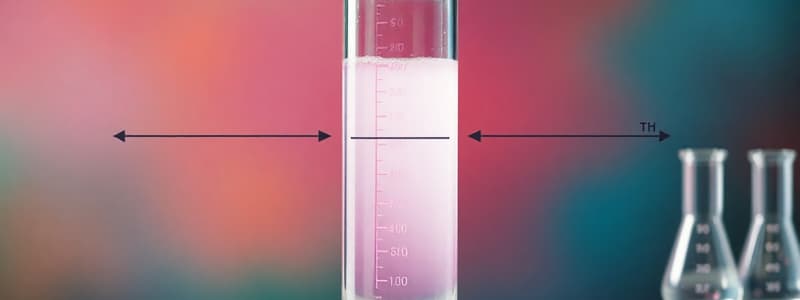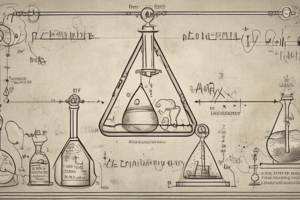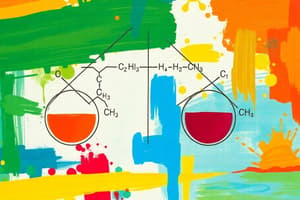Podcast
Questions and Answers
What does the law of conservation of mass state about chemical reactions?
What does the law of conservation of mass state about chemical reactions?
- The mass of reactants must equal the mass of products. (correct)
- Mass can be created in a chemical reaction.
- Mass is irrelevant to chemical reactions.
- Mass can be destroyed in a chemical reaction.
Which of the following is true when balancing chemical equations?
Which of the following is true when balancing chemical equations?
- Coefficients can be used to adjust the number of atoms. (correct)
- Balancing is only necessary for gases.
- You can change the subscripts to balance the equation.
- Elements with the same mass remain unbalanced.
What is the first step recommended when balancing chemical equations?
What is the first step recommended when balancing chemical equations?
- Balance hydrogen atoms.
- Begin with an open system.
- Balance oxygen atoms.
- Balance elements that are not hydrogen or oxygen. (correct)
In a closed system during a chemical reaction, what happens to gases?
In a closed system during a chemical reaction, what happens to gases?
How do coefficients in chemical equations function?
How do coefficients in chemical equations function?
Which of the following describes a polyatomic ion when balancing chemical equations?
Which of the following describes a polyatomic ion when balancing chemical equations?
What must be done if coefficients in a chemical equation can be simplified?
What must be done if coefficients in a chemical equation can be simplified?
What is essential to check after balancing a chemical equation?
What is essential to check after balancing a chemical equation?
What is true about the conservation of mass in a chemical reaction?
What is true about the conservation of mass in a chemical reaction?
In an open system, gases can escape during a chemical reaction.
In an open system, gases can escape during a chemical reaction.
What must be balanced first when balancing a chemical equation?
What must be balanced first when balancing a chemical equation?
The mass of the _____ must equal the mass of the products in a chemical reaction.
The mass of the _____ must equal the mass of the products in a chemical reaction.
Match the following steps to their purposes in balancing chemical equations:
Match the following steps to their purposes in balancing chemical equations:
What is the role of coefficients in a chemical equation?
What is the role of coefficients in a chemical equation?
Changing subscript numbers in a chemical formula is acceptable to balance an equation.
Changing subscript numbers in a chemical formula is acceptable to balance an equation.
What is the result of a chemical reaction in a closed system?
What is the result of a chemical reaction in a closed system?
Only the product side of a chemical equation must be balanced according to the law of conservation of mass.
Only the product side of a chemical equation must be balanced according to the law of conservation of mass.
What must be true about the number of atoms in the reactants and products in a balanced chemical equation?
What must be true about the number of atoms in the reactants and products in a balanced chemical equation?
The conservation of mass implies that the total mass of the _____ must equal the total mass of the products.
The conservation of mass implies that the total mass of the _____ must equal the total mass of the products.
Match the following elements to the order in which they are balanced in a chemical equation:
Match the following elements to the order in which they are balanced in a chemical equation:
Which of the following is a rule for balancing chemical equations?
Which of the following is a rule for balancing chemical equations?
Polyatomic ions should be counted as individual atoms when balancing equations.
Polyatomic ions should be counted as individual atoms when balancing equations.
What should be done to coefficients if they can be simplified after balancing a chemical equation?
What should be done to coefficients if they can be simplified after balancing a chemical equation?
Flashcards
Law of Conservation of Mass
Law of Conservation of Mass
The law of conservation of mass states that the total mass of the reactants in a chemical reaction must equal the total mass of the products. This means that matter cannot be created or destroyed, only transformed.
Open vs. Closed Systems
Open vs. Closed Systems
A chemical reaction in a closed system follows the law of conservation of mass. An open system allows for matter to escape, which can affect the mass of the products.
Understanding Coefficients
Understanding Coefficients
Coefficients in a chemical equation represent the number of molecules of each reactant and product involved in the reaction. They're like scaling factors to balance the number of atoms on both sides of the equation.
Balancing Chemical Equations
Balancing Chemical Equations
Signup and view all the flashcards
Balancing Rules
Balancing Rules
Signup and view all the flashcards
Balancing Order
Balancing Order
Signup and view all the flashcards
Balancing Polyatomic Ions
Balancing Polyatomic Ions
Signup and view all the flashcards
Balancing Oxygen and Hydrogen
Balancing Oxygen and Hydrogen
Signup and view all the flashcards
Study Notes
Law of Conservation of Mass
- Mass cannot be created or destroyed in a chemical reaction.
- The total mass of the reactants equals the total mass of the products (in a closed system).
- Example: 5g of hydrogen + 2.5g of oxygen = 7.5g of water.
- Open system: Reaction occurs in a non-sealed container, allowing gases to escape.
Application to Chemical Equations
- The quantity of matter (number of each atom) in reactants equals the quantity in products.
- This results in equal mass on both sides. (Atoms are just rearranged, not created or destroyed, following the law).
Coefficients in Chemical Equations
- Coefficients are numbers placed before chemical formulas to indicate the number of molecules.
- They represent the ratio of reactants needed to make products.
- Coefficients balance the number of atoms on both sides of the equation.
Balancing Chemical Equations
- Balancing ensures equal atoms on both sides, upholding the Law of Conservation of Mass.
- Do not change subscripts (these define the specific compound).
- Use coefficients to adjust the number of atoms.
Balancing Equation Order
- Prioritize balancing elements other than hydrogen and oxygen.
- Treat polyatomic ions as a single unit if they appear on both sides.
- Balance oxygen atoms.
- Balance hydrogen atoms.
- Balance any remaining single elements.
- Verify the equality of atoms on both sides.
- Simplify coefficients (reduce if necessary).
Studying That Suits You
Use AI to generate personalized quizzes and flashcards to suit your learning preferences.
Description
Test your understanding of the Law of Conservation of Mass in chemistry. This quiz covers key concepts such as mass in chemical reactions, balancing equations, and the role of coefficients. Prepare to apply these principles in various scenarios.




